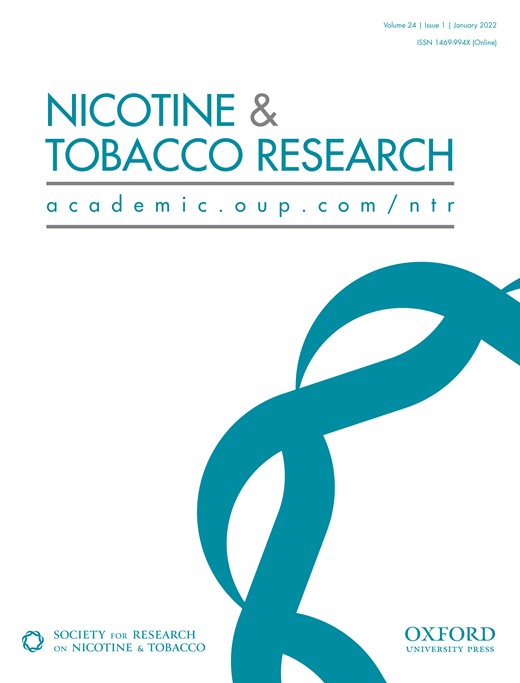-
PDF
- Split View
-
Views
-
Cite
Cite
Kylie Morphett, Coral Gartner, Informed Choice in the Context of Tobacco Use Disorder, Nicotine & Tobacco Research, Volume 24, Issue 1, January 2022, Pages 1–2, https://doi.org/10.1093/ntr/ntab215
Close - Share Icon Share
The categorization of tobacco smoking as a form of drug dependence that should be medically diagnosed and treated is received with some ambivalence by people who smoke.1 As Palmer et al. outline,2 this is partly due to the tobacco industry portraying smoking as a personal choice and a habit that can be overcome by willpower. It is also because some of the hallmarks of dependence on other drugs are not readily applicable to tobacco smoking, such as substantial intoxication and impacts on social functioning.3 Lastly, there is the question of whether the problem that needs to be addressed is tobacco dependence or nicotine dependence. This last question is becoming increasingly pertinent with the rising use of e-cigarettes and other nonsmoked nicotine delivery systems.
In their review, Palmer et al.2 present an “enhanced framework” for conceptualizing and treating tobacco dependence. The treatment of tobacco dependence has grown more complex as novel types of nicotine products become widely available. In particular, e-cigarettes have posed an “ideological challenge” in tobacco control and smoking cessation treatment4 because they do not fit neatly into the constructed categories of “bad” nicotine in combustible cigarettes and “good” nicotine in medicinal nicotine replacement therapy products.4 This has led to uncertainty about how to classify e-cigarettes. Some regulatory schemes classify them as tobacco products, but others recommend against this nomenclature because they do not contain tobacco.5 The public debate about the potential benefits and harms of e-cigarettes have caused significant confusion and unease among health professionals, concerning what advice to give about these products.6
The debate about e-cigarettes has also diverted attention away from the most harmful and widely used nicotine-containing products, smoked tobacco products. Palmer et al. attempt to redirect the field to a unifying goal of helping individuals quit smoking tobacco as a priority, even if that involves continued use of lower risk nicotine products such as e-cigarettes.2
Most individuals who smoke want to quit smoking, but as outlined by Palmer et al.,2 their choice is constrained by their pharmacological dependence on nicotine. Therefore, providing access to less harmful forms of nicotine increases the choice for individuals who find abstinence from nicotine difficult. Some may choose not to use alternative nicotine products, some may choose to use them as a short-term smoking cessation aid, and some may use them as a long-term replacement for smoking. But their choice should be an informed choice—meaning they have access to the information they need in order to weigh up the costs and benefits of available options.7 While there is uncertainty concerning the precise relative risk of vaping compared with smoking, the current scientific consensus is that e-cigarettes expose users to far fewer harmful and potentially harmful chemicals than cigarettes.8 However, media reports9 and public statements from health organizations10 that emphasize the potential risks of e-cigarettes may create the misperception that smoking cigarettes is the safer option. Research shows an increasing proportion of the public mistakenly believe that e-cigarettes are more harmful than combustible cigarettes.11,12
Health professionals have an important role to play in correcting mistaken beliefs about the relative risks of nicotine products. To do this, tools and guidelines for discussing tobacco harm reduction with patients are becoming increasingly available.13,14 These guidelines should be revised as new nicotine products emerge and research evidence develops. For example, heated tobacco products are gaining an increasing market share in some countries. On the continuum of nicotine risk15 they are likely be closer to smoked tobacco products than to nicotine products as such nicotine replacement therapy or e-cigarettes, however there is little independent research on their safety profile.16
While it is important to offer treatment to all individuals who smoke, we should also remain cognizant that many will not take up this offer, and many will continue to smoke even with the use of evidence-based smoking cessation treatments.17 In addition to the physical addictiveness of smoked tobacco products, a complex array of social, commercial and environmental factors maintain smoking behavior, particularly among populations who experience structural aspects of disadvantage.
In parallel to treating tobacco dependence, strategies to reduce the addictiveness and appeal of smoked tobacco products are needed. Implementing a very low nicotine standard for combustible tobacco products while allowing access to lower risk consumer-acceptable nicotine products, has been proposed in the United States and in New Zealand. Research suggests that such a policy could improve health outcomes for priority groups, such as those with a psychiatric condition or who experience socioeconomic disadvantage.18 This policy also has relatively high levels of public support.19,20 Banning additives and flavorings, particularly menthol, could also decrease the addictiveness and appeal of smoked tobacco products.21 Policies that reduce the affordability, availability, and convenience of purchasing smoked tobacco products are also needed to address the wider environmental context that supports continued smoking.
In combination, these policies and accurate relative risk information about nicotine products can support consumers to make healthier, or less harmful, choices, such as ceasing all nicotine use or switching to a lower risk nicotine product. Given recent policy developments and proposals to achieve a tobacco endgame,19 it may become increasingly important for health professionals to “modify their perceptions of products and treatment recommendations,” including harm reduction options, to accelerate the decline in tobacco smoking.2
Supplementary Material
A Contributorship Form detailing each author’s specific involvement with this content, as well as any supplementary data, are available online at https://academic.oup.com/ntr.
Funding
CG is supported by National Health and Medical Research Council Grant (GNT1198301).
Declaration of Interests
None declared.




Comments